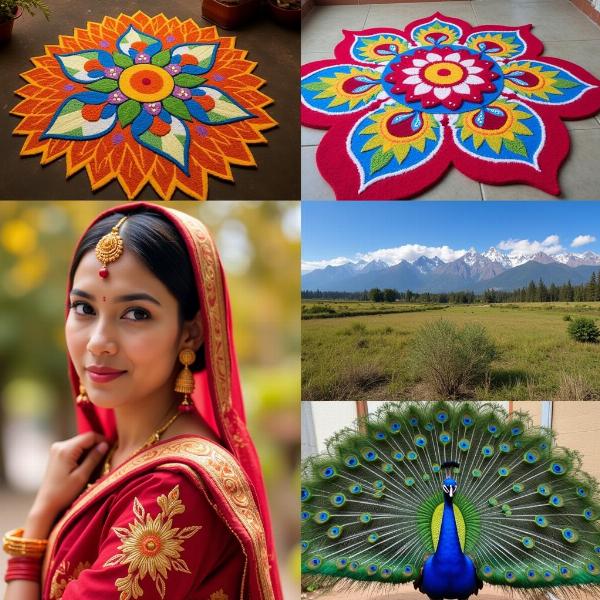Beauty, a concept universally admired, holds a special significance in Indian culture. When seeking the “beauty meaning in Hindi,” one often encounters the word “sundar” (सुंदर), which encapsulates the essence of physical attractiveness and aesthetic appeal. However, the meaning of beauty in Hindi goes far beyond mere physical appearances, delving into the realms of inner beauty, spiritual grace, and the appreciation of nature’s artistry. Understanding this rich tapestry of meanings requires exploring the diverse facets of “sundar” and its related terms, along with the cultural context that shapes their interpretations.
Unveiling the Multiple Dimensions of “Sundar” (सुंदर)
“Sundar” serves as the cornerstone of expressing beauty in Hindi. It encompasses a wide range of aesthetic qualities, from the delicate charm of a flower to the majestic grandeur of a mountain range. But “sundar” is not confined to visual appeal. It can also describe a melodious voice, a captivating story, or a noble deed. This breadth of meaning highlights the holistic perspective on beauty within Indian culture, where outward appearances are often intertwined with inner qualities.
 Examples of Sundar
Examples of Sundar
Furthermore, the meaning of “sundar” can be nuanced by adding prefixes and suffixes. For example, “ati-sundar” (अतिसुंदर) signifies exceptional beauty, while “sundarta” (सुंदरता) refers to the abstract concept of beauty itself. These variations allow for a more precise and expressive portrayal of beauty in different contexts.
Beyond the Surface: Inner Beauty and Spiritual Grace
While “sundar” frequently describes physical attractiveness, Indian culture places equal, if not greater, emphasis on inner beauty. Qualities like kindness, compassion, humility, and integrity are considered essential components of true beauty. This inner radiance is often expressed through words like “sobhā” (शोभा) which denotes grace and elegance of character.
In spiritual contexts, “sundar” can also describe the divine beauty of deities. This form of beauty transcends the physical realm and represents the ultimate expression of purity, love, and wisdom. Terms like “divya sundar” (दिव्य सुंदर) are used to denote this divine beauty, highlighting the connection between spiritual enlightenment and aesthetic appreciation.
Beauty in Everyday Life: Appreciating the Mundane
The appreciation of beauty in Hindi extends beyond the extraordinary, encompassing the simple joys of everyday life. A home-cooked meal, a child’s laughter, the warmth of a family gathering—all these can be considered “sundar” in their own right. This inclusive perspective encourages a mindful appreciation of the present moment and the beauty that exists in even the most mundane aspects of life.
Delving into Synonyms and Related Terms
Hindi offers a rich vocabulary to describe different facets of beauty. “Khoobsurat” (खूबसूरत) is another commonly used word, often emphasizing elegance and refinement. “Manohar” (मनोहर) suggests captivating beauty, while “rupavati” (रूपवती) specifically describes a beautiful woman. Exploring these synonyms and related terms provides a deeper understanding of the nuances of expressing beauty in Hindi.
The Influence of Culture and Tradition
Indian art, literature, and mythology are replete with examples of “sundar,” reflecting the enduring importance of beauty in Indian culture. From the intricate carvings of ancient temples to the vibrant colors of traditional clothing, beauty is woven into the fabric of daily life. These cultural expressions not only celebrate beauty but also reinforce the values and beliefs associated with it.
Conclusion: Embracing the Holistic Meaning of Beauty
“Beauty meaning in Hindi” transcends a simple translation of “sundar.” It encompasses a holistic perspective that embraces physical attractiveness, inner qualities, spiritual grace, and the appreciation of the world around us. By exploring the nuances of “sundar” and its related terms, we gain a deeper appreciation of the rich cultural tapestry that shapes the Indian understanding of beauty.
FAQ:
- What is the most common Hindi word for beauty? The most common word is “sundar” (सुंदर).
- Does “sundar” only refer to physical beauty? No, “sundar” can also describe inner beauty, spiritual grace, and even everyday objects and experiences.
- What are some other Hindi words related to beauty? Other related words include “khoobsurat” (खूबसूरत), “manohar” (मनोहर), and “rupavati” (रूपवती).
- How does Indian culture influence the understanding of beauty? Indian culture emphasizes both inner and outer beauty, reflecting the belief in the interconnectedness of physical appearance and spiritual qualities.
- Where can I learn more about Hindi language and culture? You can explore various online resources and books dedicated to Hindi language and culture. Meaning-Hindi.in also offers a range of translation services to help bridge the language gap and facilitate cultural understanding.
- Is there a difference between “sundar” and “khoobsurat”? While both mean beautiful, “khoobsurat” often implies a more refined or elegant beauty.
- How is beauty expressed in Indian art and literature? Beauty is a central theme in Indian art and literature, often symbolizing divine qualities and cultural values.
Discover More About Hindi Language and Culture
Explore our related articles on Hindi vocabulary, grammar, and cultural insights. Learn more about Indian traditions, customs, and the significance of language in shaping cultural identity.
Meaning-Hindi.in is your trusted partner for all your Hindi translation needs. We offer a comprehensive range of services, from business and legal document translation to website localization and educational material translation. Our team of expert linguists ensures accurate and culturally sensitive translations that meet the highest quality standards. Contact us today for a free quote! Email: [email protected], Phone: +91 11-4502-7584. Let Meaning-Hindi.in help you connect with the world through the power of language.